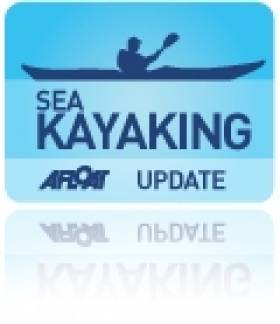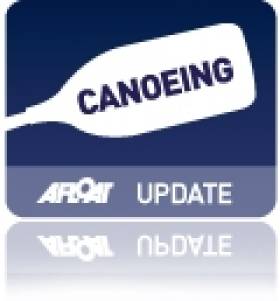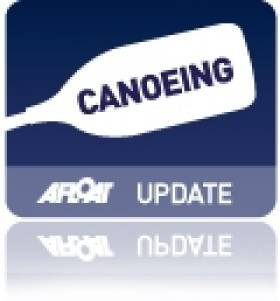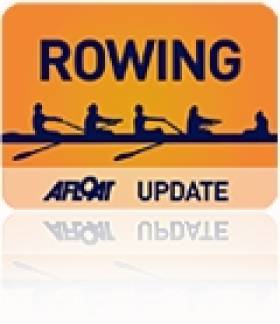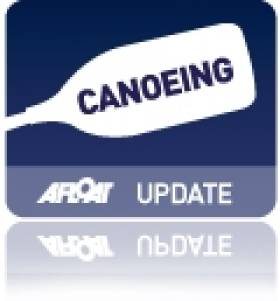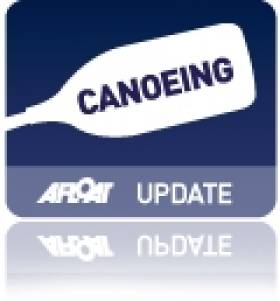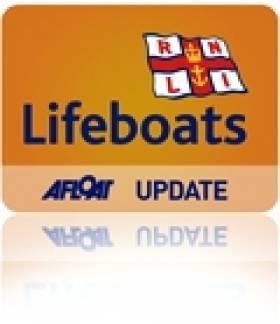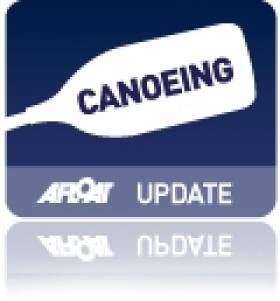Displaying items by tag: canoeing
200 Chocolate Bars Fuel Kayaker's Round Ireland Adventure
#Kayaking - It started as a result of what he called a "midlife crisis" - but the end result for Kilkenny man Paul Alexander was completing a route all around the island of Ireland by kayak in just 62 days.
And as the Irish Mirror reports, he credits a certain peanut and caramel-filled chocolate bar with giving him the energy he needed to keep going - scoffing a whopping 200 of them as he paddled his way around the coast.
Alexander, 50, set out from Kilmore Quay on his canoeing adventure, and remarkably says he only experienced "three or four hairy times when I was living on the edge" over the his months circumnavigating the island - only capsizing once.
But by far his biggest takeaway from the experience, he says, are the people he met along the way, who "reaffirmed my belief in human kindness".
The Irish Mirror has more on the story HERE.
New Kayak & Canoe Trail Planned For West Cork
#Kayaking - West Cork is getting a new kayaking and canoeing trail to encourage adventure tourism in the region, as the Irish Examiner reports.
The new paddling trail will run between Skibbereen and Baltimore along the River Ilen and will have the full funding support of Cork County Council for works that include the upgrade of Deelish Pier in Skibbereen.
“Market research shows that people are really interested in activity-based holidays. This will be a great boost to Skibbereen and Roaringwater Bay,” said Cllr Christopher O’Sullivan at a meeting of the West Cork Municipal District in Clonakilty last month.
The Irish Examiner has more on the story HERE.
Canoeing Ireland Shares In Coca-Cola Thank You Fund
#Canoeing - Canoeing Ireland is one of five sporting organisation to share in a €125,000 grant from the Coca-Cola Thank You Fund, as Business & Leadership reports.
The €25,000 to Irish canoeing's governing body comes via the soft drinks giant's initiative "aimed at encouraging people to incorporate physical activity into their day to day lives".
It's expected that Canoeing Ireland's share of the grant will help train a range of kayak instructors to get more young people interested in taking up the paddle.
Mawer and Watkins Team Up to Win Liffey Descent
#CANOEING: Gary Mawer (44) and Barry Watkins (25) in a K2 racing kayak were fastest home in the Liffey Descent race today. The new partnership covered the journey from Straffan to Islandbridge in a time of one hour 48 minutes and 39 seconds - beating the Spanish duo of Luis Amado-Perez Blanco and Miguel Llorens Lopez. Mawer, who was winning his 15th senior Liffey Descent, and Watkins, who was taking his first, did not have a single capsize. The K1 winner, Spaniard Kiko Vega (36), was making his debut in the event but also managed to negotiate the course without a capsize. Seán McCarthy led into the Palmerstown weir but took a swim there.
Liffey Descent (Selected Results)
Men
K2 – Senior: 1 G Mawer, B Watkins 1:48.39, 2 L Amado-Perez Blanco, Miguel Llorens Lopez 1:48.49, 3 T Daniels, A Daniels 1:50.02. Junior: 1 C Cummins, M Slattery 2:05.54. Masters: 1 D Halton, L McCarthy 2:04.11, 2 C Pilliner, J Hyde 2:21.32, 3 T Dillon, B O’Brien 2:23.42. Veterans: G Woodhead, C Horn 2:15.25.
K1 – Senior: 1 F Vega 1:57.17, 2 S McCarthy 1:58.48, 3 D Francis 2:00.37. Junior: 1 J O’Hagan 2:04.19, 2 F Maya Mart 2:15.59, 3 B O’Neill 2:17.09. Masters: 1 S Baker 2:01.00 2 M Banks 2:01.04, 3 J Butler 2:04.39.
Wildwater – Senior: 1 J Christie 2:07.46, 2 P Forristal 2:15.25, 3 S Hadland 2:25.12. Junior: 1 C Quinn 2:12.46, 2 C Clarke 2:23.58, 3 E Moorhouse 2:36.57.
General Purpose – Senior: 1 M Redmond 2:29.02, 2 K Cahill 2:29.54, 3 E Keyes 2:33.02. Juniors: 1 O Farrell 2:28.52, J Ledwith 2:34.10, S Cahill 2:39. 25. Masters: 1 E Broekaart 2:30.38, 2 J Mollohan 2:32.13, 3 R McKernan 2:34.08.
Canadian Triple: 1 F O’Donovan, D Comerford, C Broderick 2:46.25, 2 Y Kalogerakis, A Cobban, D Mernin 2:46.25, 3 N Slevin, M Lynch, J Byrne 2:49.35.
Canadian Double: D Bradburn, B McNulty 2:36.11, 2 K Durkan, M Fitzsimons 2:46.30, 3 J Wilkinson, H Wilkinson 2:53.00.
Touring Canadian Single: 1 A Redmond 3:18.41, 2 T Shortt 3:43.53, 3 P Magee 3:54.52.
Touring Kayak Double: 1 M Keating, D Keating 2:11.50, 2 G Collins, B Gallagher 2:14.04, 3 D McDonnell, N O’Connell 2:15.07.
Women
K1: A Smith 2:17.13.
General Purpose – Senior: 1 L Griffin 2:41.35, 2 E Kelly 2:49.03, 3 E Mulroe 3:00.18. Junior: C Gurhy 2:51.20.
Mixed
K2: 1 J Boyton, J Egan 1:58.44, 2 A Bunzel, J Smyth 2:06.15, 3 P Shelley, A Galloway 2:10.26.
Puspure and Jegou Receive Rio Scholarships
#ROWING: Sanita Puspure and canoeist Liam Jegou are among eight athletes who have been chosen by the Olympic Council of Ireland as recipients of Rio Scholarship programmes. The recipients will be supported from a fund of over €100,000 which comes courtesy of the OCI in association with the International Olympic Committee’s solidarity programme.
Jegou took silver at the Canoe Slalom Junior World Championships this year and was fourth at the European Junior Championships.
Puspure, a single sculler, took fourth place at the World Rowing Championships and a bronze medal at the European Championships. In her World Cup campaign, she made the A Final in Aiguebelette, and won the B Final at Lucerne.
The full list of athletes receiving scholarships is: Chloe and Sam Magee (badminton mixed doubles): Sanita Puspure (rowing); Liam Jegou (slalom canoeing), Bryan Keane (triathlon), Lisa Kearney (judo), Andrew Smith (gymnastics) and Natalya Coyle (modern pentathlon).
'Try Canoeing' Event In Co Down This Weekend
#Canoeing - Banbridge Canoe & Kayak Club will host a 'Try Canoeing' event for the public this Saturday 20 September, as the Banbridge Leader reports.
All the action will take place on the new flat canoe slalom course at Gilford, Co Down – halfway between Banbridge and Portatown – as part of Northern Ireland's Get Outdoors Weekend.
And the event is open to people of all abilities, so don't be put off if you're a novice on the water.
The Banbridge Leader has more on the story HERE.
Canoeist Hendrick Takes Silver for Ireland at Youth Olympic Games
#CANOEING: Ireland’s Robert Hendrick took a silver medal in the C1 Obstacle Slalom at the Youth Olympic Games in Nanjing in China. The event is run on a head-to-head format and the 16-year-old took on and beat Leon Breznik of Slovenia in the semi-finals. In the final, Hendrick lost out to France’s Lucas Roisin, who won gold. Hendrick is coached by three-time Ireland Olympian canoeist Eoin Rheinisch.
Youth Olympic Games, Nanjing, China (Irish interest)
Canoeing: C1 Obstacle Slalom – Semi-Final: 1 Ireland (R Hendrick) 1:18.752, 2 Slovenia (L Briznik) 1:25.750.
Final: 1 France (L Roisin) 1:18.179, 2 Ireland (R Hendrick) 1:19.047.
Ballycotton Lifeboat Rescues Four Teenage Canoeists
#RNLI - Ballycotton RNLI has rescued four teenagers who got into difficulty yesterday evening (Thursday 31 July) when out on a canoeing venture.
The volunteer crew was alerted shortly after 8pm and requested to go to the aid of four canoeists who were sheltering from a southerly wind at Ballycotton Lighthouse.
The all-weather lifeboat under coxswain Eolan Walsh launched at 8.15pm and made its way to the scene approximately a mile from shore.
Conditions at the time were challenging: well as a Force Four wind, which was at times reaching Force Five, there was also a one to two metre sea swell.
On arrival, the Ballycotton crew proceeded to take three canoeists on board the lifeboat. A fourth teenager escorted by the lifeboat managed to make their way safely to shore at Ballycotton Harbour.
Speaking following the callout, Ballycotton RNLI lifeboat operations manager John Tatton said: "The group made the wise decision this evening to call the lifeboat for help once they got into difficulty.
"The four, all of whom were wearing lifejackets had been out canoeing for a number of hours and got caught out by the weather as it deteriorated. We were delighted to assist and glad that all have been returned safe and well to Ballycotton tonight."
#CANOEING: Ireland’s Liam Jegou finished fourth in the final of the Canoe Slalom European Junior Championships in Skopje in Macedonia today. The C1 competitor did very well in his semi-final and actually was the fastest man in the final, but the four second penalty for two touche on gates cost him a medal. He will team up with Cade Ryan in a C2 in Sunday’s semi-final, one of two Ireland boats which has qualified.
Canoe Slalom European Junior and Under-23 Championships, Skopje, Macedonia (Selected Results; Irish interest):
Men
Junior - C2 Heats (20 Qualifiers): 15 L Jegou/R Cade 154.64; 16 R Hendrick/N Hendrick 157.39.
C1 Final: 1 Italy 113.18: 4 Jegou 116.99 (4 second penalty for two touches)
Women
Under-23 – K1 Heats (20 qualifiers): 23 A Conlan 129.72 seconds.
Jegou Shoots Into European Canoe Slalom Semi-Finals
#CANOEING: Ireland’s C1 canoeist Liam Jegou qualified comfortably for the semi-finals of he Canoe Slalom European Junior Championships at Skopje in Macedonia today. Jegou, whose mother is Irish and who was brought up in Ireland before moving to France, finished fifth of the 20 qualifiers after the first two runs. There were some problems with the timing at the event.
Canoe Slalom European Junior and Under-23 Championships, Skopje, Macedonia (Selected Results; Irish interest, unofficial)
C1 Junior Heats (top 20 qualify): 5 L Jegou 117.94 seconds; 27 R Hendrick 134.98.
K1 Junior Heats (top 30 qualify): 36 C Ryan 120.71; 40 O Farrell 127.58; 53 N Hendrick 190.69.


























